Product Requirements:
Device:
Windows PC 98, 2000, ME, XP or later
When people say that size doesn’t matter, they are lying. With some things,
bigger is better. However, this is not true when it comes to PDAs. Here, smaller is almost always better. The
reigning
king of Pocket PCs is the HP 5400 series. Although packed with features and
style, this PDA isn’t exactly shirt pocket size. To remedy that, late last year
HP introduced the 1910. This device was their
first true small form factor Pocket PC, and as such, gained a popular following
even though it lacked some of the more powerful features such as Bluetooth and WiFi.
This summer, HP has introduced 3 new iPaq models running
the latest version of the Pocket PC 2003 operating system: the 1940, 5500
and the 2215. It is the 2215 that we will be looking at in this review. I think
this model might just be the next king of the Pocket PC. Small enough for a
pocket and infused with enough features to satisfy most people, this one is a
winner. Read on to see if you agree.
Hardware Specifications
Operating System: Microsoft® Windows® Pocket PC 2003 Premium
Processor: 400 MHz Intel® XScale technology-based processor
Memory: 64 MB SDRAM (56 MB main memory)
Display: 16-bit Transflective TFT color (65,536 colors) 240 x 320 pixel 3.5 in (96 mm)
diagonal
Expansion: SD slot: SD, SDIO, and MMC support, CF Slot: Compact Flash Type I and
II
Infrared port: IrDA SIR
Integrated Bluetooth™ (ver. 1.1)
Battery: Rechargeable 900 mAH Lithium-lon user swappable battery
AC Power: AC Input: 100~240 Vac, 50/60 Hz; AC Input current: 0.2 Aac max Output
Voltage: 5Vdc (typical); Output Current: 2A (typical)
Dimensions: (L x W x H) 4.54 x 3.00 x 0.61 in. (115.4 x 76.4 x 15.4 mm)
Weight: 5.1 oz (144.2 g)
What’s In The Box
HP iPAQ Pocket PC 2215
USB Desktop cradle/charger
AC Adapter, battery, and charger adapter
Slip case
Getting started poster
HP iPAQ Pocket PC Companion CD
I’ve been using Palm’s Tungsten | T
as my main brain for the last 9 months. I’ve actually not used a Pocket PC to do
much of anything in all that time. So, I have been itching to dive back into
using a Pocket PC and was excited when the HP iPAQ 2215 evaluation unit showed
up on my doorstep. Having seen pictures on the web, I didn’t think I’d be blown
away by the style of the device, as it just didn’t seem as sexy as the 1900
series. But, looks aren’t everything and I didn’t want to judge a book by its
cover until I actually had the device in hand.
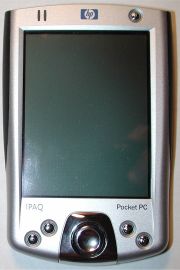
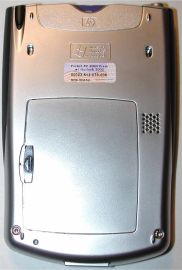
Upon first inspection, I would say that the 2215 was related to the iPAQ family. But to me it looks more
like a cousin than a brother to the 1900 and 5400 series. The casing is more
chunky than the streamlined body of the other iPAQs. There is also no question
that the casing of this device is plastic. With the other iPAQs, they had a
definite metallic look to them. In hand, the 2215 is a good fit. It is small and
light weight, making it very comfortable to hold and use. I don’t know if it is
just my imagination, but the plastic body almost feels like it has a very thin
rubber coating. This gives you a secure grip on the PDA without any slippery
feeling.

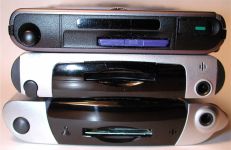
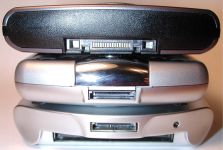
Top to bottom: Tungsten | T, HP2215, 3800 iPAQ
Speaking of grip, my first test was to give the 2215 the good ol’ Gadgeteer
squeeze test. Although the 2215 is a solid little PDA, it did yield a few creaks
and groans
when I squeezed the sides in my hand. I didn’t feel any flexing of the plastic,
but I could feel the rubber side grips move a bit. Shaking the PDA only caused
rattling of the stylus in the silo.
The case is made of matte colored grey plastic with chrome and black plastic
/ rubber accents. The look is a little more utilitarian than the snazzy 1900 or
5500 series. It is larger than the 1900, while still being very compact.
Above the display is the power button and two status / alarm LEDs. The power
button is small, but easy enough to press. Holding the button for a few seconds
turns the backlight off on the screen. There are two LEDs, which are indicators
for the built in Bluetooth radio and for alarms. The left LED is the Bluetooth
LED. It flashes blue when you have the radio turned on. The LED on the right is
the alarm LED and battery charging LED. It will flash amber while charging, and
then glow solid amber when the battery is fully charged. It will also flash
green as a visual event alarm.
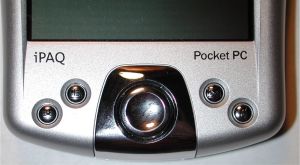
Below the display are the 4 application buttons and the navigation button.
The application buttons are small and a little stiff to press. They are slightly
smaller in size than the same buttons on my 3800 series, and are recessed into
the case to guard against accidental activation. I’ve never been a big fan of
the navigation button on every iPAQ model (except the 1900) that I’ve had. On the other
hand, the navigation button on the 2215 is wonderful! It is a smooth and shiny button with a
large indention on the top that is perfect for resting a finger tip or thumb.
The button moves effortlessly in any direction, including pressing it in. All of
the buttons have great tactile feedback.
The display on the 2215 is gorgeous and very easy on the eyes. I compared it
with the screen of a friend’s 1910, and it is very similar. It is crisp, bright
and clear. Perfect for e-book reading! The 1910 might have the slightest edge as
far as color vividness, but other than that, they are almost identical. Like the
1910, the 2215 does not have an ambient light sensor. So you can’t set it to
automatically adjust the screen brightness level based on surrounding light. I
have no complaints at all in this area though, as I never used that feature
anyway.
| Screen size comparison | |
| 3800 series iPAQ | 3.10 x 2.34in (78.8 x 59.5mm) |
| 1910 series iPAQ | 2.86 x 2.16in (72.7 x 54.8mm) |
| 2215 series iPAQ | 2.88 x 2.18in (73.2 x 55.5mm) |

Unedited image taken without flash and full brightness setting.
Those fond of ClearType will be happy to know that included with the OS is a
new tuning utility that allows you to adjust the level of anti-aliasing, or
smoothing, of text.
The touch screen is adequately sensitive and easy to write on with a stylus.
Although you can see the screen depress slightly when pressed with a stylus, it
is slick and does not feel spongy at all.
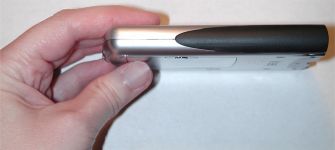
The left and right sides of the 2215 have hard rubber grips that remind me of
the side rails on the Toshiba e570. I
wouldn’t be surprised if replacement grips weren’t offered in different colors
soon. The grips are nice, but they do creak a bit.
At the top of the device is the microphone, 3.5 mm headphone jack, IR, stylus
silo, SD and CF slots…
Although there is a microphone, there isn’t a dedicated voice recorder
button. You can reassign one of the application buttons for this task though.
People that use the voice recorder feature a lot, might find this omission to be
annoying. I personally rarely if at all record anything, so it doesn’t bother
me. Unlike the 1910, the 2215 does have a standard sized earphone jack. So,
using your favorite ear buds or headphones will be no problem. Audio quality
through the earphone jack is great and the maximum volume level is more than
adequate.


The IR port is hidden behind the black plastic that surrounds the SD and CF
slots. IR strength is pretty strong. I was able to control my TV from as much as
20 feet away. HP put the Nevo Universal Remote Control software in ROM, which makes the 2215 double as a
really nice remote for your home theater.
The stylus that comes with the 2215 is a boring plastic toothpick… It is
usable, but you’ll probably want to upgrade to something nicer ASAP.
In my opinion, the best feature that the 2215 has, is its dual memory card
slots. With both SD and CF slots, there is no need for expansion sleeves like on
previous iPAQ models. You can use the SD slot for a memory card or SDIO device,
and the CF slot for a memory card, GPS or WiFi card. Or, if you’re a total
memory junkie, you can put a 1gb CF card in one slot and another memory card in
the SD slot. Totally sweet if you ask me. This is a major selling point for me
because I have digital cameras that use CF cards. The ability to take the CF
cards directly from the camera and insert them into the 2215 for viewing is
great!
The connector on the 2215 is the same as the iPAQ 3800, 3900 and 5400 series
models. This is very nice because it allows you to use other peripherals
designed for those models such as keyboards, charging, syncing cables etc. As
for charging, the 2215 comes with a cradle that includes a slot for charging a
2nd battery. The cradle is a little too light weight for my taste though as it requires
two hands to remove the PDA which is a little annoying…
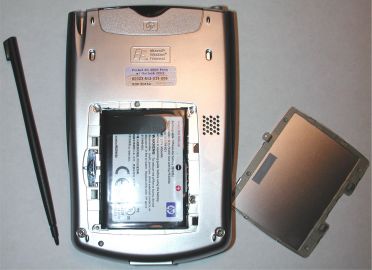
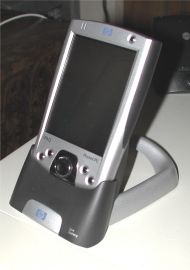
On the back of the PDA is the speaker and battery compartment. The speaker
has adequate volume and can easily wake you up if you want to use the 2215 as an alarm
clock. The battery compartment is easy to access as it has a spring loaded lock. The battery capacity of the
2215 is the same as the 1910: 900mAH. According to HP, the estimated usage
time of a fully charged battery is up to 12 hours. I guess this is with the screen
and speaker turned off as I did my own test that you can see below.
| Battery Level | Time Used | Activity | Screen Brightness Level / Volume Level thru built-in speaker / headphones |
| 100% | 1:30pm – 2:30pm (60min) | Media Player Playing MP3s thru earphones | Screen Off / 50% |
| 90% | 2:30pm – 3:30pm (60min) | Media Player Playing MP3s thru speaker | 50% / 50% |
| 70% | 3:30pm – 4:00pm (30min) | Reading e-books with Palm Reader | 50% / 50% |
| 64% | 4:00pm – 4:30pm (30min) | Powered off | n/a |
| 64% | 4:30pm – 5:00pm (30min) | Surfing the web via a Socket WiFi card in the CF slot |
50% / 50% |
| 52% | 5:00pm – 5:30pm (30min) | Powered off | n/a |
| 52% | 5:30pm – 6:00pm (30min) | Image Viewer slideshow pulling images from CF card |
50% / 50% |
| 37% | 6:00pm – 8:00pm (120min) | Powered off | n/a |
| 30% | 8:00pm – 8:05pm (5min) | Image Viewer slideshow pulling images from CF card |
50% / 50% |
| 25% | 8:05pm | First low battery warning | 50% / 50% |
| 25% | 8:05pm – 8:30pm (25min) | Image Viewer slideshow pulling images from CF card |
50% / 50% |
| 15% | 8:30pm – 9:00pm (30min) | A little of this and a little of that | 100% / 50% |
| 13% | 9:00pm | End of test | 100% / 50% |
| Total usage time 4hrs 30mins / Total powered off time 3hrs |
|||
Memory wise, the 2215 comes with 64mb of RAM of which 57mb are available to
the user and 3.8 available in the non-volatile file store. With both an SD and
CF slot, that should be oodles for almost any user.
There is one feature that the 2215 has that I can do without: Bluetooth. I
wish it had built in WiFi instead. I didn’t test the Bluetooth feature much at
all. I did see if my Tungsten | T could recognize it, and it could. Microsoft did send
a CF WiFi card to me to test with the 2215. I had used a WiFi card with previous
iPAQs, and found setup to be a real pain! It’s nice to see that with this new
version of the OS, those setup problems are a thing of the past. All I had
to do was install the Socket device driver on the iPAQ, plug the card in, and
boom, I was surfing! Very nice!!!
Overall system speed with the 2215 is snappy. Very snappy. I was pretty
surprised at how quickly I could load a 1mb .jpg image from a CF card and display it.
On older versions of the OS, this would take forever. With the 2215, the
pictures load and display in about 5 secs!
Now we get to the software side of things. The software bundle that comes
with the 2215 is actually pretty decent…
Software Included In ROM
- Pocket Outlook – This is your PIM (Personal Information Manager) Suite of
applications. You get Contacts, Calendar, Tasks, Notes, and Inbox. All of
these applications will sync directly to Outlook on your desktop PC - Pocket Internet Explorer – Web browser
- Pocket Word – View and edit Word documents
- Pocket Excel – View and edit Excel documents
- Block Recognizer – Graffiti clone input method. If you have a Palm OS PDA
and know Graffiti, then you’ll be right at home with this input method. - Voice Recorder, Calculator, Solitaire
- iPAQ Task Manager – Access and launch programs easily
- Diagnostic Tool Kit
- iPAQ Backup – Utility for Backup/Restore to Main Memory, Memory Card, or iPAQ
File Store - iPAQ Image Viewer – View images and create slide shows
- Nevo – Universal Remote Control
- iPAQ File Store – Non-volatile storage in flash ROM
- Adjustable Standby Settings – Utility for adjusting power conservation modes
- Utilities – Self Test, iPAQ Audio, Power Status
- Windows Media Player 9 for Pocket PC – Listen to digital music and watch
movies - Microsoft Reader for Pocket PC – Read electronic books
- Jawbreaker – New bubble popping game
Optional Applications (and demos) on CD:
- ActiveSync 3.7
- Microsoft Outlook 2002
- Audible – Your Pocket PC can read you the morning paper or a best selling
audiobook and replay your favorite public radio program – anytime you want - Vindigo – Tell Vindigo where you are and what you’re looking for, and it
will direct you to thousands of places to eat, shop and play - RealOne Player – Access RealAudio and RealVideo news, sports,
entertainment, and other informative programs from the Internet - MARGI Systems Inc.’s Presenter-to-Go – Give presentations created in
PowerPoint or any printable Windows application on your iPAQ™, or simply view
presentation notes and text content - iPresentation Mobile Converter LE – Allows you to view Microsoft
PowerPoint presentations on the Pocket PC - Peacemaker Professional – Beam information to and from a wide range of PDA
devices, IR-equipped desktop or notebook computers, or text-scanning pens - Adobe Acrobat Reader for Pocket PC – View Adobe Portable Document (PDF)
files on Pocket PC devices - Ilium Software eWallet (Professional Edition, Trial Version) – Store,
protect, and back up your important information - Ilium Software ListPro (Professional Edition, Trial Version) – Make, use
and re-use all your important lists - F-Secure FileCrypto for Pocket PC Personal Edition – File encryption
application that provides protection against unwanted data disclosure - Pocket Watch – The Interactive World Clock For Pocket PC – Tap to find
what time it is all across the world
Along with all the good, there are a few nits to pick, and one is a pretty
big nit… My first complaint is that powering the unit on doesn’t feel quite as
instantaneous as other Pocket PCs. It feels like there is a 1-2 second lag
between pushing the power button and having the unit actually come on.
My other complaint is quite a bit more serious. There seems to be a serious
problem with the OS and the way it handles alarms. Several times, I have noticed
that my appointment alarms were not turning on the PDA and notifying me.
Sometimes I would turn the PDA on, and find the alarm waiting for me on the
screen. This is a big problem as I’m sure you’ll agree. If you can’t depend on
your PDA to alert you to your meetings, then what good is it? I will say that
this problem didn’t happen 100% of the time. But, just knowing that there is a
problem would make me a little worried about depending on the 2215. Here’s
hoping that HP will release a patch to fix that problem as soon as possible. I’m
pretty confident that they will.
Hardware-wise, I’m quite happy with the 2215. It is a robust little PDA that
has the most important features that I personally could want. With 2 memory / IO
card slots, to me it is more powerful than its much more expensive big brother,
the 5555. I know the 5555 has 128mb RAM, built in biometric security, a larger
battery and WiFi, but at $250 more than the 2215, is it really worth it? To me
it isn’t. The extra card slot means I have a smaller, more compact PDA, that
doesn’t require me to carry along a expansion sleeve. Battery life on the 2215
was fine for me. The ability to carry a spare battery is a real plus. About the
only thing I would change if I could on this PDA, is to switch Bluetooth for
WiFi. As is though, the 2215 is a great PDA for the price. If you’re in the
market for a Pocket PC, you really owe it to yourself to check this one out.
Price: $399.99
Pros:
SD and CF slots
Great screen
User replaceable battery
Bluetooth
Cons:
Alarms don’t always sound
Slight pause when powering on
Small capacity battery
Lack of a jog dial
Breloom SH6 Handheld Terminal, Windows 11 Pro, Intel N100, 8GB+256GB, 6.5" Rugged Data Terminal PDA, 4G LTE/GPS/WiFi 6/BT 5.2, 5000mAh Battery (SH6)
$569.99 (as of January 6, 2026 22:23 GMT -06:00 - More infoProduct prices and availability are accurate as of the date/time indicated and are subject to change. Any price and availability information displayed on [relevant Amazon Site(s), as applicable] at the time of purchase will apply to the purchase of this product.)CHUWI Hi10 X2 Windows 11 Tablet 10.1'', Intel Core i3 (up to 3.9GHz), 8GB RAM 256GB SSD, Windows Tablet PC, 4K Micro HDMI, WiFi 6, BT 5.3, USB 3.2, Dual Cameras, Type C, with Case
$239.59 (as of January 6, 2026 19:11 GMT -06:00 - More infoProduct prices and availability are accurate as of the date/time indicated and are subject to change. Any price and availability information displayed on [relevant Amazon Site(s), as applicable] at the time of purchase will apply to the purchase of this product.)Product Information
| Price: | |
| Manufacturer: | Hewlett Packard |



Gadgeteer Comment Policy - Please read before commenting
Post your comments here on the HP iPAQ 2215 Pocket PC Review.
http://www.the-gadgeteer.com/hp2215-review.html
Just click the POST REPLY button on this page.
Hi Julie,
There was a long conversation over on our website a few weeks ago about the reminder problem. It does appear as if it is not fundamentally tied to the hardware, but rather certain software (either in the firmware or installed on top). In particular, the Pocket Backup bundled in the iPAQ’s ROM may be triggering scheduling problems.
http://www.pocketpcthoughts.com/forums/viewtopic.php?t=15621
Glad to hear you’re enjoying the new device! Nice pics, as always. 😉
–janak
Julie, splendid review! I am planning to buy a 2215 myself very soon, as soon as I sell my Toshiba e740 and stuff anyway! :). It really is an awesome device!
I should sell my old 3800 and accessories and buy my own 2215. I was sad to send it back today 🙁
🙁 Well, you are THE gadgeteer! I am sure you have TONS of stuff to sell :).
So Julie, will this device dethrone your TT?
I am really wondering if I sould switch to Pocket PC the next time I upgrade. I have used Palm for five years, but my brother just got an Axiom and I love how great the display looks, especially how it uses the whole screen. I_really_ hope Palm starts using some kind of virtual grafitti very soon.
I just have so much time, energy, and software invested in Palm. I don’t know if I could switch.
Doug:
It would definately replace my T|T if I owned one of my own. The full size display on the 2215 really does it for me. Reading e-books is wonderful on it. Having 2 memory card slots is also very nice!
I think I’m going to hop back to the Pocket PC for awhile and see how things go. But right now, the only ones I have are a 3800 iPAQ and a Viewsonic.
Thanks for bringing up the alarm problem. With enough discussion and ‘bad press’about this hoprefully MS/HP will respond more quickly than they otherwise would.
Mike
forrester:
I too had a lot invested in Palm software when I had my Treo. When I switched to PPC, I wrote to many of the companies who supported both platforms and asked them if I could switch my license to the PPC platform. Most all of them switched me for free or some small fee.
Great review Julie! I just bought a 2215 last week. I still have my 1910 and I can certainly attest to the speed of the 2215! It’s fast!
I agree about the WiFi. I bought a D-Link CF card and am surfing and emailing with ease. I even read this review with my wireless setup!
Lisa
I just bought the 2215 Friday. It is a great looking device and it is what many people have been wanting for years now in an iPaq(refering to the dual slot).
BUT I have to say that the alarm problem is the killer for me to sent this puppy packing. It is going back to the store tomorrow. I guess I will go back and get a TRUSTY ‘ole Palm, maybe the TT2.
I set an alarm every night before I go to bed to make sure I test my 5 yr. old son’s blood who happens to be diabetic. This nightly test is critical and make all the difference in how well he will sleep through the night and feel in the morning.
How can I possible rely on this went already I have had 2 nights and a morning alarm not go off until I powered the device on?
I do QA for a living and can’t fathum how someone overlooked something as basic and as common of a feature.
🙁
Fantastic review!
It’s almost sure that the backup software causes the problem. This software is made by http://www.spritesoftware.com and they have a patch for the 22xx series.
I have been switching back and forth between Palms and Pocket PC’s for years. I was using a Tungsten T and went to the HP 2215. After a week or two I exchanged the HP 2215 for a Tungsten T2. The 2215 is nice in alot of ways but the built in Microsoft apps are still terrible. They are so bad that I am betting Microsoft doesn’t want Pocket PC’s to be so good as to interferewith laptop or especially Tablet PC sales (which haven’t been too good btw). I installed all the usual add on apps to try to improve things but that causes other problems and I still can’t find anything like To Do Plus on the Palm which is something I use alot. How hard is it to make a simple To Do app for Pockets PC anyway? Listpro ain’t it btw. So I got a Tungsten T2 and couldn’t be happier. It has a great screen and the new silver color is nice. Also more memory and a little faster than the previous vesion. When you want to get things done quickly and efficiently the Palm still has it all over the Pocket PC IMHO. I’ve also been impressed with how much Palm has improved their products when I thought for awhile they were a goner due to lack of innovation. I looked at the 2215 screen in CompUsa the other day and compared it to the T2 and I think the T2 is much better. Are you going to review the T2?
tthiel:
Reviewing the T2 hasn’t made my list of things I would like to review. I’m more looking forward to the iQue (if we ever get one that is…).
– A lot of utility like battery pack has not been updated several week ago. If you install them it won’t work.
-todoplus? It’s called built in task. (category, alarm reminder, sorter, linker, beaming, notes)
This is todosplus manual
http://www.handshigh.com/html/todomanual.html
PS. of course if you have used PPC for a long time, you knew that right.
The 2215 does not support large PCMCIA hard drives from Kingston or Toshiba–2, 5, and probably 15Gb PC Card drives.
Jason Dunn sent HP a note, and between HP, Semsons, Toshiba, and Kingston, they are all pointing the finger at one another.
Otherwise, I’m a converted Palm user.
After hearing about the 2215, and seeing a friend at work with one, I had to get one. Now hearing about the problems with alarm sounds, which is very, very important to me is not good. If I knew there was a definitive fix to this problem available before I bought the 2215, I would get one. Otherwise, I’m looking at the TT2. I’ve been using Palm for so long now, that I’d really like to try something different.
I thought the Palm was everything because I replaced my Franklin Planner with it…
I got the iPAQ 3955 a few months ago and I found out how powerful the PocketPC platform has become–beyond a PIM/planner device.
The 2215 gives me the mobility and strength in platform that the 3955 showed me–gaming (GameBoy Color, GameBoy Advanced, SuperNES, GameGear, NES, Commodore64, Atari, Arcade games through Mame, etc.), ebooks, a true universal cIR remote control (Nevo), wireless security assessment, Web surfing, digital camera, Instant messaging through (AIM & MSN Messenger), Acrobat, Office applications, listening to MP3s, watching DIVX and WMV encoded full feature movies, and expandability (that’s why I’m slightly miffed at losing my 5Gb Toshiba PC Card hdd).
I think that we’re on the verge of replacing our laptops.
what current PDA with CF or SD card slot can read PCMCIA cards? it seems that would be physically impossible without some sort of kludgy adapter.
if you need PCMCIA support in a small form factor you should get yourself an apple newton, a windows CE handheld pc, an hp 200lx or omnigo, or maybe a subnotebook.
-10bt
It’s a Semson’s CF-to-PCMCIA adapter. Julie did a review on it a while back. It’s actually elegant with the 2215–you place a Cisco Aironet or Orinoco Wifi card in the adapter, plug it into your CF slot of your 2215, fold the card back, and stuff it into your Vaja case and you don’t even see it.
I tried this with the Toshiba hdd and you would never know that you had 5Gb storage in such a small form factor. To bad the 2215 doesn pump out enough voltage to make the card fully operate. Go to Brighthand or PocketPCThoughts for more info.
Divx movies on the 2215 is nice!
If you want to use PC Card drives, you’d be better off with the 5500 iPAQ and a PC Card sleeve. Bulky, but doable… Or, go buy one of those just announced 4gb CF cards from Lexar! 😀
I think this is where alot of Palm and Pocket PC users diverge. I don’t want to watch movies, listen to MP3’s, or take pictures with my PDA. It does all of those things adequately but I want all of those things done really well. I have an ipod for MP3’s, a Canon S230 for digital pictures and watch movies on a laptop, lcd screen or TV. I think people who want Pocket PC’s as multi-purpose devices are more willing to put up with it not being a very good organizer because it does all those other things.
Uh yeah…I know what Tasks is. Tasks is awful and is nowhere near as useful as To Do Plus. I can do most things in To Do Plus with one or two steps isntead of the four or five it takes in Tasks. I’m really baffled as to why Tasks, a relatively simple application is so poorly done.
It was surprising to me how much better the T2 is. The screen is really great, it’s a little faster, and has twice the memory. Definetly an improvement. Maybe I have too much disposable income but I had no problem buying oe to replace my Tungsten.
huh?
first of all it has today’s plug in, and there are several freebie to do plug in for even more elaborate filter.
second it has tap hold for quick line management and finally the edit page is all in one page. It is 2-3 steps to get anywhere. It is DEFINITELY better than todo plus, not to mention cheaper.
true enough there is only 3 priorities, but it has unlimited categories.
The usual PI/AF is the prefered method for more complicated to-do.
what exactly you mean by “poorly done”? you mean it doesn’t have cutesy icons on the bottom and use tap and hold instead?
Julie,
What I love about my 2215 is the Bluetooth connection to my cell phone (Sony Ericsson). I have GPRS service on the phone and can access the internet from the 2215. No hotspots required, unlike WiFi. Internet access anywhere there is Cingular GPRS. Just go to the browser on the 2215 and everything is automatic. I can be up to 30 feet away from my phone and still connect!
Like you I also use the 2215 to view digital pics on compact flash from my Canon. A bit slow however. (Is the Tungsten T faster?)
I plan to get an SD WiFi card so that I can use my WiFi access point at home (free). So the two slots on the 2215 and Bluetooth will be fully utilized. Cool! 😎
Regards,
Dan
I know about all the doodads and add-ons and have tried them all. The fact that is has an edit PAGE alone is ridiculous. But whatever, believe what you will. The fact that there are so many replacements for Tasks should tell you something….
….huh?
In case you didn’t notice the irony, TodoPlus IS a todo replacement, while we are talking about PPC built in Todo, and its today plug in capability. So if there is one thing not right or a crippled built in todo, that would be PALMs. PPC todo alterntive are far beyond what any POS apps can muster. PI and AF are example where advance todo functionality are sold as replacement. (eg. nobody will buy todoplus in PPC scene, since it’s what the built in app does)
1. afaik, todoplus does use edit page (or pop up windows)
2. todoplus does not have tap and hold and today’s page screen. Both facilitate short cuts and auto info display.
3. PPC todo are not bound by POS note size limitation or category limitation, it also support audio recording.
so the claim that todo plus can do more, or “use less tap” are pretty dubious, reading from todoplus manual.
PS. how did you use your PPC? I am curious now… and more specifically, what did you mean by ‘poorly done todo’?
I think the 2215 has really balanced functionality, size and prize. The 2215 is my first PocketPC and its been a great experience so far!
Great review Julie.
I have been having this same problem with my 1910. Here is what I have found. If I don’t sync with another computer AND I don’t add a meeting to the calendar with an attachment, everything works.
To correct, I have to make a backup with the Sprite software, hard reset, restore without any of the items from Outlook then resync. BIG PAIN.
Other ideas are welcome.
“size does matter” ???
Yes it does. But my view on it is different!
I do not like the Palms — I broke several of them. Same thing happened with my first Pocket PC. Only the CASIO was comfortable.
I see the same trend going in Pocket PC’s to smaller and smaller.
OH NO!!
My HP 3835 WITH expansion sleeve is JUST the right size: small enough to fit comfortably in my pants pocket when I don’t feel like it being in a beltcase. But it is large enough that it is comfortable to hold, not going to get lost when in a bag with other things, and too large to “forget”. Besides, my Dual CF sleeve (normal cladding) gives me access to 2x CF cards without adding too much size. (a 256SD for programs and then 2x 512 CF — one for music, one for other documents)
I will admit the big dual PC card sleeve is about the max I want — I only use it when I need the battery time.
The screen could be larger (my eyes are getting older) and the entire device could add maybe 1/2 inch top-bottom, right left, and maybe 1/4 – 1/2 inch thick. I love the versitility of the expansion sleeves — something the newer models lack (although they incorporate a lot of expansion already with two slots!) The Dell Axiom is just a little on the small size (but I really like the Compaq expansion sleeves!)
I’m not really knocking — just trying to show that there is another side. Some of us don’t like the little ‘flimsy’ 1910 — or the other small devices. We aren’t going to put it in our shirt pocket!!
It is a replacement for a laptop, for me!
But then, that is why there are so many different
Don’t hold your breath – PPC2002 also had easily documented problems with alarms not sounding and Microsoft never even admitted them.
Jorgen
I really don’t understand why you would like to trade Bluetooth for WiFi. How many people use Wifi with their PDA?
I have WiFi at home and at work, and use it with my laptop and desktops, to avoid network cables running all over the place.
But the PDAs I sync them using bluetooth all the time, works just fine. And, I don’t surf the web with my PDA unless I am forced too, which means I am on the road. In that case the chances of having WiFi access are rmote (currently), but using bluetooth and my cellphone I can use GPRS just about anywhere. (Note: I could browse the web using BT if I wanted too, but I don’t 😉
And using bluetooth gives me much more flexibility to use peripherals: I can also connect to my bluetooth GPS receiver, perfect companion for the navigation software (TomTom on the Ipaq, Digimap on the Palm).
After having used Ipaqs a lot at work, I am now on my second Palm, the brandnew Tungsten T2. Yeehaa!!!!
The reason why I would rather have WiFi over Bluetooth is because I have a WiFi network at home, but don’t have a Bluetooth phone. Most (if not all) Bluetooth phones are GSM phones. GSM (T-mobile in my area) has a crummy coverage area where I live.
OK, so for you *personally* WiFi makes more sense than BT. But objectviely, BT gives much more flexibility than WiFi, because it allows you to communicate with other devices (phones, etc).
In the review you make it sound like BT in stead of WiFi is a fundamental shortcoming of the Ipaq. In stead, it should be presented as your opinion, which of course you are perfectly entitled to have.
And regarding the phone: CDMA and TDMA phones as used in the USA, Canada and the rest of the Americas, will eventually support Bluetooth. It will just take longer, same thing happened with SMS, MMS, WAP, etc. That is just the result of a highly fragmented market (rest of the world is almost entirely GSM).
For the rest I like the review 😉
Hi Julie,
I just recently bought an HP 2215 myself. This was after having a disastrous flirtation with a Palm Pilot (way back), and swearing never to own another PDA. One of my chief complaints back then was the inability to schedule appointments as fast as I would have liked to in real time. I see that the limitations of Pocket PC software don’t make it much easier. It still takes a while to schedule a simple appointment with a Pocket PC.
However, that wasn’t the real reason I decided to cave in. What I was looking for was a small and transportable device where I could check in on my emails and website from time to time while away from the office. I could do that with my old Palm Pilot, but the limitation was that I had to have a land-line to jack into to make a call to an ISP. Furthermore, Web browsing was dismal back then.
So fast forward to the HP 2215, and what you didn’t like is something I find indispensable. I’ve been using the on-board Bluetooth to dial up my ISP via my Bluetoothed Sony Ericsson cell-phone. I don’t even have to remove my cell phone from its case, and an acceptable connection is quite easy to establish as if by magic! It trudges along at an acceptable speed, albeit it is still a de-facto dial-up connection.
Ok, why not Wi-fi you ask? Well I learned an expensive and quite painful lesson when I first got this ensemble. I was so enamored with the cool GPRS connection that I surfed away merrily and found myself saddled with a $400 internet express bill for data!!! So, now I am using plain old dial up into Earthlink via bluetooth to my cell-phone. These days minutes are cheap, and nights and weekends are free. It’s fractionally slower, but it sure doesn’t cost an arm and a leg either.
So there you have it. I use Bluetooth every single day to 1) surf the net, and secondly to transfer files back and forth between my computer and my PDA.
I still wish there was an easy way to schedule appointments. In this regard Palm wins hands down. Otherwise, the 2215 is a winner.
Bob,
With Earthlink, is there an 800 number they don’t charge extra for — when you travel?
So it’s airtime on the cell phone plus the $22/mo for Earthlink unlimited service? Are those the total costs?
Also, should I be getting rid of GPRS, at least until there is an unlimited-use product arround at a decent price?
Thanks,
Dan
HP 2215
SonyEricsson T616
Dan,
First of all, yes, Earthlink/Mindspring does have a national and international 800 number one can use, but I never use them. The reason is, the 800 number actually costs me more– Earthlink I believe has a small charge for using the 800 number. I have Nation-wide service on my cell phone and also Earthlink has a local number in almost every city in the United States. This makes an 800 number a moot point.
With straight dial-up, there are no hidden costs. Since I have free nights and weekends on my cellular plan, and unlimited dial-up via Earthlink, I could presumably stay logged on all night and all weekend at the basic phone and ISP charge.
I still have GPRS, but I must admit to being shy about using it now. Although there is no charge for a connection, any data uploaded or downloaded goes against my data quota. This month, I downloaded a few images and before I knew it, I was way over quota. I will explore GPRS again when they come out with a higher data allowance at a decent price.
For what it’s worth, I do not notice that much difference between straight dial-up and GPRS anyways.
I have had my 2210 for about a week now. I was previously using a 3765 on a daily basis for e-prescribing, dictation and reference (I am a Family Doc) using an 802.11b PC card and sled. I will be using the 2210 as soon as a driver becomes available for PPC2003 for our CF 802.11b cards.
The combination of small size, and DUAL slots sold me. I was very frustrated with my 3765 in that I could not run a wireless card and memory card at some time. The faster processor is nice as well.
I can tell I am in love, but then I always fall in love with my latest gadget for at least a month, then it is time for something new.
bl
Greetings,
In general I liked the review of the HP. I would have liked to have more information on the Bluetooth capabilities which I understand is not all that important to you but is invaluable for some of us.
In regards to Bob’s comments about GPRS I am wondering who your provider is? T-Mobile now has an “all-you-can-eat” GPRS plan for $19.99/mo. Hopefully other providers will follow suit shortly. Also, not to beat the drum for Palm but, there are Palm devices that now have Bluetooth built-in or can accept a BT SDIO card. I played with a Tungsten T2 today and the BT setup was unbelievably easy. You answered 4 questions, 1) do you have a GPRS device, 2) what country are you in, 3) who is your service provider and 4) what phone do you have? In less than 30 secs I had a connection to my Sony-Ericsson T68i via BT and was surfing the web. I tried to do the same with an HP 2215 and was unable to connect due to not being able to figure out how to specify the correct phone number to dial my GPRS provider. I only wish Palm would put CF expansion slots in their devices and provide for replaceable rechargeable batteries.
To the poster that said “we are on the verge of replacing our laptops” I’d have to say, Not just yet. It is really apalling at how poorly the Pocket PC applications integrate with their desktop cousins. ActiveSynch seems problematic from what I have read on the net and neither Palm nor PPC devices are truely sufficient for serious web surfing due to the lack of Java support, lack of multiple browser windows, and versioning issues with Pocket IE. We are getting closer and I have high hopes for the future but I just don’t think we’re there yet. 😀
Cheers
TC
Cingular is my cellular provider. I’m afraid I’m locked-in to them. I need to keep my phone number. And secondarily, T-Mobile has the Sony Ericsson T610 not the T616 which is a little better phone IMHO. (See mobileburn.com) So I’m using Earthlink just like Bob. (Nothing is perfect.)
Maybe with time, Cingular will also offer “all you can eat”.
Is it really made of plastic?
I’ve looked at it closely ad the battery door of the 2210/2215 is made of metal. The bottom part of the body is finished in true iPAQ Satin finish and the top part is painted silver.
Now Looking at it closely, it does resemble the same manufacturing standards of the other iPAQs such as the 36xx, 37xx, 38xx, 39xx, and 55xx.
Now I remeber very well that there was a similar discussion about the HP Jornada 568 being made in plastic… which turned out to be wrong.
Now the Jornada 548 anf the Tungsten T or T2 may be made with stamped aluminum sheets… thin and requiring a backbone to support them… the Jornada 568 on th other hand was made of some lightweight alloy which was more of a cast alloy or a machined alloy, which gave the fel that it was made of plastic… because of the wholeness of the chassis.
The 1910, 1930, 1940 and 2210 seem to be made of the same process… the se of alloys for part of the structure or probably the most of it.
I wouldn’t discount the fact that the strength of the structure may be a result of such design… a cast alloy design.
But then again, I can be wrong… and using a continuity tester for the bottom half of the body to check if it would conduct electricity proved that it does conduct electricity… Good chrome plating on a plastic part? Or is it truly made of metal?
Also, pay attention to the detail. Look at the fine holes made for the mic. It would be very difficult to do something as fine as that on plastic… same goes for the notification light apertures.
Mabuhay! ~ Carlo
Bob,
I am also interested in what carrier you are using that allows you to dial in to a dial up ISP such as Earthlink. Is that really a lot slower than a GSM/GPRS connection?
When I first got my Nokia 3360 from AT&T (which uses TDMA) I thought I would able to do this. Nokia told me the phone was capable of this, but that AT&T had crippled the capability.
Come 11/24 I am dumping ATTWS because the cost of their data plans is too high. The problem is that I need a carrier with low cost data, but also at least voice coverage for my summer place near Bath, ME. TMO has cheap data, but is GSM only and cuts out 2 miles short. I am looking at VZW and Sprint, but your solution might give me other options until other carriers get their act together for a reasonably priced data plan.
You need a carrier that provides GPRS — just don’t use the service, use voice instead. I found out the hard way by cancelling GPRS (with Cingular), trying to save $6.99 their lowest cost GPRS, and discovering I could not connect because the “modem” part of the phonecall was gone. I called back and reinstated GPRS. Now I can dial out *and connect* to a dial-up. 😀
As I said, I thought I would be able to do what Bob did with using my Nokia 3360 as a cellphone modem for my laptop with ATTWS, but ATTWS’ TDMA system did not allow it. I see that they now offer phones that are advertised as GSM (voice) and GPRS (data and “mMode”). If I stayed with them and switched to one of the new phones, would they be able to block my calling a dial-up ISP or to know that I was doing so and charge me their absurd bandwidth rates?
So many acronyms, I’m not sure this answers your question. But when I dial out on my SonyEricsson T616 to dialup to Earthlink, Cingular is charging me voice rates not data rates.
I first off praise your intensely detailed review~near dead on! However, I caution readers to justly understand that your personal issues with this PDA might just be as one person wrote, “…somewhat inhibitive of alternately installed software…” Reason being, I have never witnessed these personal occurances nor deficiencies! Not only any one of them – but NONE of them! It literally works flawlessly and perfectly. So, again, I caution readers to precisely and openly view this as but ONE article and ONE PDA. It simply shouldn’t have been stated in the CONs area your recognized faults, but that maybe it was a bit deeper than skin deep causing this to reflect upon this HP product as a whole! (And NO-NO-NO-NO!!! I do not work for HP!:-)” Have you tried to contact HP and discuss these issues to see if maybe your unit was just dropped off the conveyor belt accidentally upon building it??
AXNJXN:
If you are referring to the failure for Calendar alarms to be fired, this is a well documented issue with the 2215 or with Windows Mobile 2003 devices in general (it doesn’t happen with 2003 Second Edition). It has to do with the number of appointments in the Calendar app and how long it takes for the maintenance tasks to be performed every day. There are even small ‘patches’ that you can make to your device to help eliminated the issue. FYI: I have all my Calendar appts from as far back as the year 2000…
i have a question…
do this iPAQ 2215 Pocket PC have a slot for a sim card??
if yes please teach me how…
I take it you didn’t read the review, which said it was a PocketPC – and not a PocketPC PHONE, which would suggest it might have a SIM card slot… if it was a GSM phone. Which it’s not.
So, the short answer is ‘no, no SIM card slot’.
i have an hp ipaq. and im looking for a charger. do you have one or any idea where i can find one?
more info:
pocket pc 2003 pro
w/outlook 2002
00023-524-577-281
x09-50650
regulatory model #: hstnh-h03c-wl
hello
I want to ask you, please, can you tell me if it is somehow possible to charge the Pocket pc 2003 premium w/ outlook 2002 with the usb??